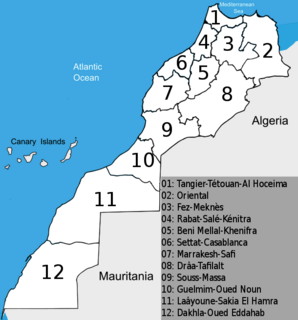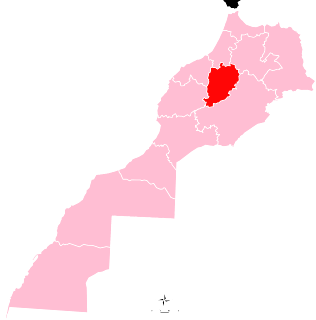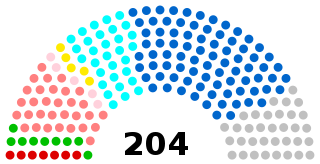
France is divided into 18 administrative regions, which are traditionally divided between 13 metropolitan regions, located on the European continent, and 5 overseas regions, located outside the European continent. The 13 metropolitan regions are each further subdivided into 2 to 13 departments, while the overseas regions consist of only one department each and hence are also referred to as "overseas departments". The current legal concept of region was adopted in 1982, and in 2016 what had been 27 regions was reduced to 18. The overseas regions should not be confused with the overseas collectivities, which have a semi-autonomous status.

Regions are currently the highest administrative divisions in Morocco. Since 2015, Morocco officially administers 12 regions, including one that lies completely within the disputed territory of Western Sahara and two that lie partially within it. The regions are subdivided into a total of 75 second-order administrative divisions, which are prefectures and provinces.

Grand Est, previously Alsace-Champagne-Ardenne-Lorraine, is an administrative region in eastern France. It superseded three former administrative regions—Alsace, Champagne-Ardenne, and Lorraine—on 1 January 2016, as a result of territorial reform which was passed by the French legislature in 2014. Alsace-Champagne-Ardenne-Lorraine was a provisional name, created by hyphenating the merged regions in alphabetical order; its regional council had to approve a new name for the region by 1 July 2016. France's Conseil d'État approved Grand Est as the new name of the region on 28 September 2016, effective 30 September 2016. The administrative capital and largest city is Strasbourg.

Auvergne-Rhône-Alpes or ARA is a region of France created by the territorial reform of French Regions in 2014; it resulted from the merger of Auvergne and Rhône-Alpes. The new region came into effect on 1 January 2016, after the regional elections in December 2015.

Bourgogne-Franche-Comté is a region of France created by the territorial reform of French Regions in 2014, from a merger of Burgundy and Franche-Comté. The new region came into existence on 1 January 2016, after the regional elections of December 2015, electing 100 members to the regional council of Bourgogne-Franche-Comté.

Hauts-de-France, is a region of France created by the territorial reform of French Regions in 2014, from a merger of Nord-Pas-de-Calais and Picardy. Its capital is Lille. The new region came into existence on 1 January 2016, after the regional elections in December 2015. France's Conseil d'État approved Hauts-de-France as the name of the region on 28 September 2016, effective 30 September 2016.

Regional elections were held in France on 6 and 13 December 2015. At stake were the regional councils in metropolitan and overseas France as well as the Corsican Assembly and inaugural seats in the Assembly of French Guiana and Assembly of Martinique, all for a six-year term. The Departmental Council of Mayotte, which also exercises the powers of a region, is the only region not participating in this election, having already been renewed on 2 April 2015. There are 18 Regional Presidencies at stake, with 13 in continental France and Corsica, and 5 overseas. Though they do not have legislative autonomy, these territorial collectivities manage sizable budgets. Moreover, regional elections are often taken as a mid-term opinion poll.

Laâyoune-Sakia El Hamra is one of the twelve regions of Morocco. It is mainly located in the disputed territory of Western Sahara: the western part of the region is administered by Morocco and the eastern part by the Sahrawi Arab Democratic Republic. The region as claimed by Morocco covers an area of 140,018 square kilometres (54,061 sq mi) and had a population of 367,758 as of the 2014 Moroccan census. The capital of the region is Laâyoune.

Guelmim-Oued Noun is one of the twelve regions of Morocco. The southeastern part of the region is located in the disputed territory of Western Sahara and a small strip of land in this area is administered by the Sahrawi Arab Democratic Republic. The region as a whole covers an area of 46,108 km2 and had a population of 433,757 as of the 2014 Moroccan census. The capital of the region is Guelmim.

Souss-Massa is one of the twelve regions of Morocco. It covers an area of 51,642 km² and had a population of 2,676,847 as of the 2014 Moroccan census. The capital of the region is Agadir.

Drâa-Tafilalet is one of the twelve regions of Morocco. It covers an area of 88,836 km2 and had a population of 1,635,008 as of the 2014 Moroccan census. The capital of the region is Errachidia.

Tanger-Tetouan-Al Hoceima is one of the twelve regions of Morocco. It covers an area of 15,090 km² and recorded a population of 3,556,729 in the 2014 Moroccan census. The capital of the region is Tangier.

Béni Mellal-Khénifra is one of the twelve regions of Morocco. It covers an area of 28,374 km2 and recorded a population of 2,520,776 in the 2014 Moroccan census. The capital of the region is Beni Mellal.
The first round of the 2022 French presidential election will be held between 8 and 23 April 2022, with the second round held two weeks after the first. Should no candidate win a majority of the vote in the first round, a runoff will be held between the top two candidates two weeks later. The incumbent president is Emmanuel Macron of La République En Marche!, who won the 2017 presidential election and whose term lasts until 13 May 2022.

The regional council of Auvergne-Rhône-Alpes is the deliberative assembly of the region of Auvergne-Rhône-Alpes. Laurent Wauquiez of The Republicans (LR) is the current president of the regional council, elected on 4 January 2016, following the regional elections on 6 and 13 December 2015.

The first Regional Elections of Nord-Pas-de-Calais-Picardie were held on 6 and 13 December 2015. At stake were the Regional Council of Nord-Pas-de-Calais-Picardie.

The regional council of Bourgogne-Franche-Comté is the deliberative assembly of the region of Bourgogne-Franche-Comté. Marie-Guite Dufay of the Socialist Party (PS) is the current president of the regional council, elected on 4 January 2016, following the regional elections on 6 and 13 December 2015.

The regional council of Grand Est, formerly the regional council of Alsace-Champagne-Ardenne-Lorraine, is the deliberative assembly of the region of Grand Est. Jean Rottner of The Republicans (LR) is the current president of the regional council. He was elected on 20 October 2017, following the retirement of Philippe Richert on 30 September 2017.





















